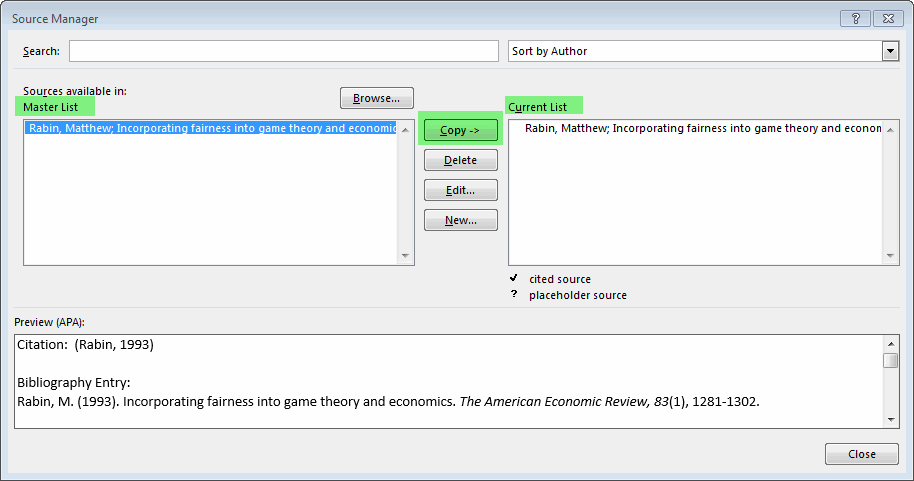
The “ Edit Source” option takes you to the corresponding entry in the Source Manager, where you can enter additional information on the work or change existing information.

In addition, you can select information that shouldn’t be shown in the reference. “ Edit Citation” also allows you to edit the page number where the quote can be found in the original text. You’ll now have the option to adjust the reference. To do so, click on the reference using the right mouse button. The entry will be saved under this name and can be adjusted at a later time.Ī citation’s reference isn’t just a normal piece of text in your document: It’s an object that you can select and edit. To create a placeholder, simply enter a tag name. If you don’t have the necessary information for the cited work immediately at hand, you can add a placeholder and provide these details later. On the other, Word gives you the option to work with placeholders. You’ll also find two more options under the “ Insert Citations” option: On the one hand, you can enter a new source directly into your list here. To do so, first insert the footnote and then enter the reference. If you don’t want to enter citations directly into the text, you can also work with footnotes. The reference will now appear in the text (in the selected format). Use the cursor to navigate behind the citation and click on the relevant source. When you click on it, Word will show you a list of all sources you’ve entered.


You’ll find the “ Insert Citation” button under the “ References” tab. Once you’ve used a quote in your work, you can simply add the corresponding reference to the original. Although a short reference is given to the original work in the text itself, the user can find more comprehensive details about the cited work in the bibliography (such as the date of issue and edition in addition to the author and complete title). These references and the bibliography are closely linked: in general, every source of a citation is listed in the closing bibliography. It ensures that you don’t forget a certain reference.Ĭitations directly reproduce the wording from another author, and they are unambiguously marked so that you don’t commit plagiarism. What’s more, a well-structured bibliography can help you do your research even while writing the document. Plus, citations enable you to clearly delineate which ideas and statements are your own and which come from other authors: it’s clear whose knowledge your work builds on. These should be listed at the end of the paper, allowing the reader to delve deeper into the subject’s literature. To "extend" the types, but that suggestion is really aimed at implementors of a Word Processing program, not at people who merely want to modify Word's behaviour.Whether it’s an essay, report, a bachelor’s or master’s thesis or a dissertation, in academic papers you always refer to sources. Yves also provides some facilities for creating new "types", but I cannot

To "extend" the types, but that suggestion is really aimed at implementors of a Word Processing program, not at people who merely want to modify Word's behaviour. Think Yves ever posted anything other than an experimental version.Īs far as I know, Microsoft's list of "types" (Book, Film etc.) were, in effect, fixed by the creation of the Office Open XML standard - in other words, you would really have to modify the standard to introduce new ones. Just about the only good technical information about Word bibliography was created by Yves Dhondt, who posted a number of utilities at .
#UPDATE THE BIBLIOGRAPHY IN WORD 2016 UPDATE#
to correct a typo, or add missing details), just click Update Citations and Bibliography in the Bibliography section of the EndNote X9 toolbar in Word, and the changes you have made will appear in your document also. (This is really little more than a kludge, as I did not have time to understand all of Microsoft's XSL code.) If you edit a reference in your EndNote library subsequent to inserting it in your document (e.g.
#UPDATE THE BIBLIOGRAPHY IN WORD 2016 HOW TO#
One answer describes how to modify the editing language - it is possible that there is a simpler way than that. It is likely that Word uses different XSL now, but you can check out . I did try to modify the XSL to work around that particular problem, but in response to a question about Word 2007/2010. Or to modify the XSL, which also requires that you distribute *your* XSL to anyone who needs to edit the document and recreate the bibliography. Unless the "et al." problem has been fixed, the only ways to fix it would be to modify the primary editing language to one that uses "et al." rather than "y otros", to use find/replace on the results of the bibliography fields,


 0 kommentar(er)
0 kommentar(er)
